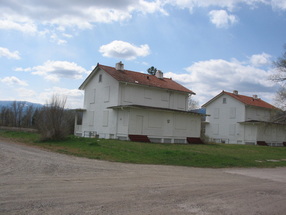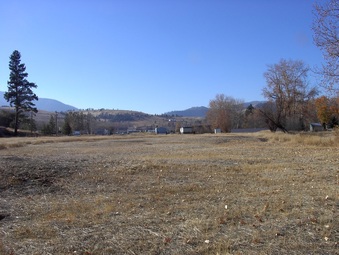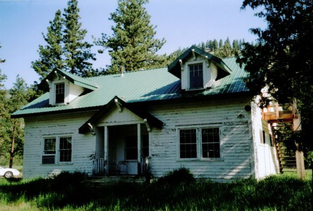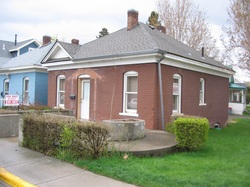2009 Eleven Most Endangered Historic Sites
1. Missoula Country Fairgrounds Buildings

Agricultural Building,
Missoula County Fairgrounds.
The Missoula County Fairgrounds Buildings represent an important part of Missoula’s social history as well as western Montana’s quickly disappearing agricultural heritage. Ongoing planning processes continue to discuss the fate of these buildings and the property as a whole. PHM has been instrumental in alerting the public and encouraging a closer look at fairgrounds development. Continued participation in the planning discussions will help insure the representation of the public’s interests in these buildings.
2. Missoula Historic Districts
PHM considers all of Missoula’s historic districts and proposed historic districts without any regulatory guidelines endangered. The lack of guidelines highlights the problems inherent with new construction in historic districts and the need for zoning codes that require sympathetic treatment of historic districts. The City of Missoula zoning codes are currently being revised. PHM will encourage the development of appropriate zoning for our historic districts.
3. Buildings #14 and #16, Non-Commissioned Officers Quarters, Fort Missoula Quarters.

NCO Quarters at Fort Missoula
These two structures were constructed in 1910 and originally served as living quarters for the Non-Commissioned Officers stationed at Fort Missoula. The two duplex buildings are contributing buildings to the Fort Missoula Historic District. They are two-and-one-half story residential stucco structures with full-length porches running along the front and back, and they mimic the Mission style of architecture prevalent at Fort Missoula. The 1984 Fort Missoula Historic Resources study noted that the buildings were vacant and in disrepair. The University of Montana currently owns the buildings, and PHM would encourage the University to adaptively reuse these historic buildings as part of their expanding presence and mission at Fort Missoula.
4. Travelers’ Rest and the Lolo Trail

Looking west from Travelers Rest National
Historic Landmark towards the site
of the proposed cellular tower installation
Historic Landmark towards the site
of the proposed cellular tower installation
Trileaf Corporation is proposing a 185 foot high metal cellular communications tower which will be located on a ridge above the confluence of Mormon Creek and Lolo Creek. The proposed tower will be within the boundaries of the Lolo Trail NHL and within the boundaries of the historic landscape for Travelers Rest NHL. Visitors to Travelers Rest remark that the view shed remains intact, much like the views experienced by the Corps of Discovery over two hundred years ago. The cell tower would have a negative effect on both National Historic Landmarks. Preserve Historic Missoula would request Trileaf to construct their tower in a different location that would service their cellular customers while avoiding any negative impacts to these two National Historic Landmarks.
5. Original Missoula County Courthouse, 431-435 N. Third Street West

This building is a portion of the original Missoula County Courthouse, which was moved from the site of the present courthouse to N. Third and converted to use as apartments. It is one of the oldest frame buildings remaining in Missoula. The building is going up for sale and is in danger of demolition or further deterioration. PHM encourages recognition of the building’s significance and its preservation as a significant part of Missoula’s history.
6. Bonita Ranger Station

The Bonita Ranger Station is located in the Missoula District, Lolo National Forest, north of I-90 and the Rock C reek interchange. The property was determined eligible for listing in the National Register of Historic Places in 1990. The Missoula Ranger District vacated the remaining buildings at Bonita in anticipation of selling the property. However, the Forest Service’s authority to convey buildings has expired. In the meantime, FS Region 1 completed a study to rank the importance of its historic administrative sites. Bonita ranked high in comparison to other properties. As a result, the Forest Service will need approval from the Regional Forester to dispose of the property—if and when the conveyance authority is renewed. PHM understands the problem with surplus property, but believes that Bonita would be well suited for use under a Special Use Permit. Alternatively, if the district does eventually convey the site out of federal ownership, full mitigation of the adverse effect will be necessary.
7. Historic Missoula Public School Buildings

Missoula County Public Schools
Administration Building, 6th Avenue
Administration Building, 6th Avenue
These school buildings reflect the establishment of public school education in the community and the development of the education system in the twentieth century. The requirements of modern education systems, changing populations patterns, and development pressures endanger the preservation of these important parts of our history. PHM encourages rehabilitation of buildings for educational use and urges deed restrictions on school building sales to prevent their demolition or their conversion to properties that do not reflect their historical significance. Significant school buildings include:
|
|
8. Alder Street Workers’ Housing

Historic home on Alder Street.
These small houses on tiny lots are in close proximity to the Pine Street mansions, reflecting a history of class integration within one of Missoula first neighborhoods. In general, preservation of mansions is more widely supported than preservation of workers’ housing; yet, workers’ housing is equally significant to the economic and social history of any community. With the increasing attractiveness of downtown residential housing, the workers’ houses are subject to tear-down or insensitive renovation.
9. Lincoln School
The Lincoln School property represents a community landmark as well as an important component in the history of Missoula’s education system. Current development plans indicate the loss of open space around the school and its conversion to a peripheral building in a housing development. PHM continues to encourage and assist a non-profit group, Save Lincoln School, in its ongoing efforts to preserve the building’s integrity.
11. Tremper House, 600 University Avenue
The present home of the University of Montana’s Native American Studies—and the last house remaining on the block—retains high architectural and structural integrity, but is in danger of demolition after the program moves to a new building now under construction. PHM can encourage reuse rather than demolition of the property for parking or some other function.
